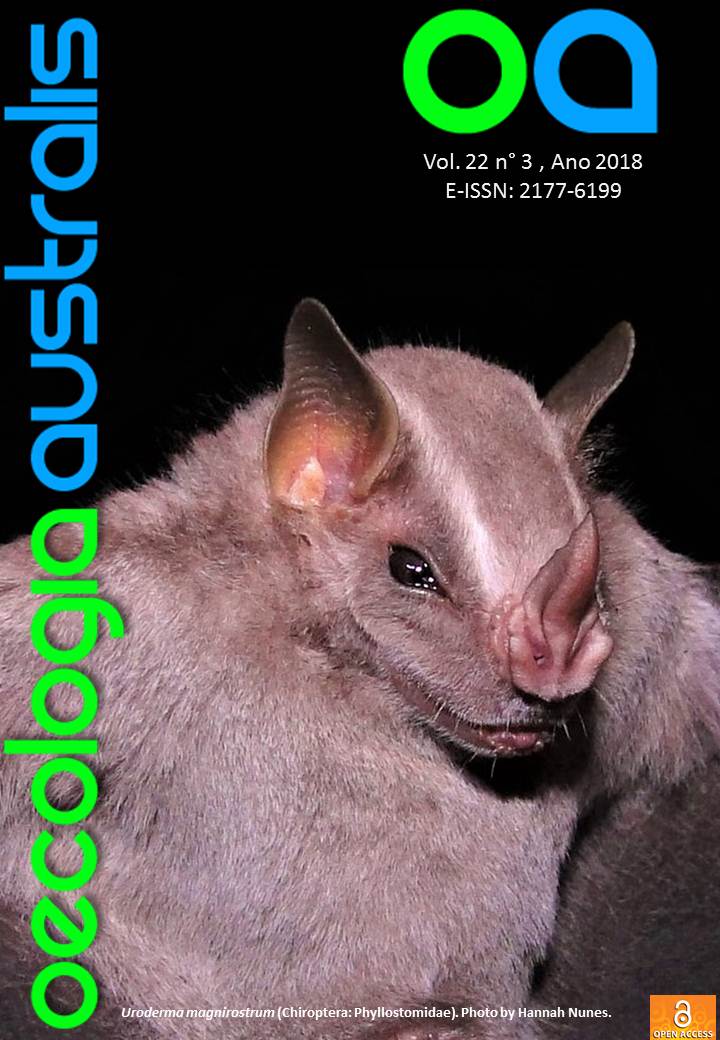EDITORIAL OECOLOGIA AUSTRALIS - Setembro/2018
Downloads
References
Baar, Y., Friedman, A. L., Meiri, S., & Scharf, I. 2018. Little effect of climate change on body size of herbivorous beetles. Insect Science, 25, 309--316. DOI: 10.1111/1744-7917.12420
Brandão, M. V., Garbino, G. S. T., Godoy, L. P., Silva, L. A., & Pascoal, W. 2015. New records of Chironectes minimus (Zimmermann, 1870) (Didelphimorphia, Didelphidae) from central Brazil, with comments on its distribution pattern. Mammalia, 79(3), 363--368. DOI: 10.1515/mammalia-2014-0037
Brooks, S. J., Self, A., Powney, G. D., Pearse, W., Penn, M., & Paterson, G. L. J. 2017. The influence of life history traits on the phenological response of British butterflies to climate variability since the late 19th century. Ecography, 40, 1152--1165. DOI: 10.1111/ecog.02658
Campbell, C. D., Sarre, S. D, Stojavic, D., Gruber, B., Medlock, K., Harris, S., MacDonald, A. J., & Holleley, C. E. 2018. When is a native species invasive? Incursion of a novel predatory marsupial detected using molecular and historical data. Diversity and Distributions, 24, 831--840. DOI: 10.1111/ddi.12717
Green, R. E. 1998. Long-term decline in the thickness of eggshell thickness of the thrushes, Turdus spp., in Britain. Proceedings of Royal Society of London - Series B, 265, 675--684. DOI: 10.1098/rspb.1998.0347
Kotiaho, J. S., Ahlroth, P., Haimi, J., Monkkonen, M., & Vilkuna, J. 2009. Evolution education in natural history museums. Trends in Ecology and Evolution, 24, 292--293. DOI: 10.1016/j.tree.2009.02.006
Lister, A. M. 2011. Natural history collections as sources of long-term datasets. Trends in Ecology and Evolution, 26, 153--154. DOI: 10.1016/j.tree.2010.12.009
Parmesan, C. 1996. Climate and species' range. Nature, 382, 765--766. DOI: 10.1038/382765a0
Schäffer, S., Zachos, F. E., & Koblmüller, S. 2017. Opening the treasure chest: A DNA-barcoding primer set for most higher taxa of Central European birds and mammals from museum collections. PLoS ONE, 12(3), e0174449. DOI: 10.1371/journal.pone.0174449
Shaffer, H. B., Fisher, R. N., & Davidson, C. 1998. The role of natural history collections in documenting species declines. Trends in Ecology and Evolution, 13, 27--30. DOI: 10.1016/S0169-5347(97)01177-4
Suarez, A. V., & Tsuitsui, N. D. 2004. The value of museum collections for research and society. Bioscience, 54, 66--74. DOI: 10.1641/0006-3568(2004)054[0066:TVOMCF]2.0.CO;2
Van der Valk, T., Durazo, F. L., Dalen, L., & Guschanski, K. 2017. Whole mitochondrial genome capture from faecal samples and museum-preserved specimens. Molecular Ecology Resources, 17, e111--e121. DOI: 10.1111/1755-0998.12699
Viscardi, P. 2016. Natural history collections - why are they relevant? The Guardian. https://www.theguardian.com/science/punctuated-equilibrium/2011/apr/12/2


